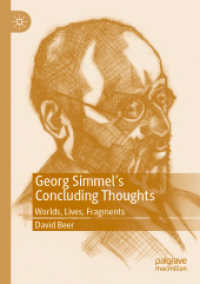Full Description
The 39-volume set, comprising the LNCS books 13661 until 13699, constitutes the refereed proceedings of the 17th European Conference on Computer Vision, ECCV 2022, held in Tel Aviv, Israel, during October 23-27, 2022.
The 1645 papers presented in these proceedings were carefully reviewed and selected from a total of 5804 submissions. The papers deal with topics such as computer vision; machine learning; deep neural networks; reinforcement learning; object recognition; image classification; image processing; object detection; semantic segmentation; human pose estimation; 3d reconstruction; stereo vision; computational photography; neural networks; image coding; image reconstruction; object recognition; motion estimation.
Contents
SimpleRecon: 3D Reconstruction without 3D Convolutions.- Structure and Motion from Casual Videos.- What Matters for 3D Scene Flow Network.- Correspondence Reweighted Translation Averaging.- Neural Strands: Learning Hair Geometry and Appearance from Multi-View Images.- GraphCSPN: Geometry-Aware Depth Completion via Dynamic GCNs.- Objects Can Move: 3D Change Detection by Geometric Transformation Consistency.- Language-Grounded Indoor 3D Semantic Segmentation in the Wild.- Beyond Periodicity: Towards a Unifying Framework for Activations in Coordinate-MLPs.- Deforming Radiance Fields with Cages.- FLEX: Extrinsic Parameters-Free Multi-View 3D Human Motion Reconstruction.- MODE: Multi-View Omnidirectional Depth Estimation with 360o Cameras.- GigaDepth: Learning Depth from Structured Light with Branching Neural Networks.- ActiveNeRF: Learning Where to See with Uncertainty Estimation.- PoserNet: Refining Relative Camera Poses Exploiting Object Detections.- Gaussian Activated Neural Radiance Fields for High Fidelity Reconstruction & Pose Estimation.- Unbiased Gradient Estimation for Differentiable Surface Splatting via Poisson Sampling.- Towards Learning Neural Representations from Shadows.- Class-Incremental Novel Class Discovery.- Unknown-Oriented Learning for Open Set Domain Adaptation.- Prototype-Guided Continual Adaptation for Class-Incremental Unsupervised Domain Adaptation.- DecoupleNet: Decoupled Network for Domain Adaptive Semantic Segmentation.- Class-Agnostic Object Counting Robust to Intraclass Diversity.- Burn after Reading: Online Adaptation for Cross-Domain Streaming Data.- Mind the Gap in Distilling StyleGANs.- Improving Test-Time Adaptation via Shift-Agnostic Weight Regularization and Nearest Source Prototypes.- Learning Instance-Specific Adaptation for Cross-Domain Segmentation.- RegionCL: Exploring Contrastive Region Pairsfor Self-Supervised Representation Learning.- Long-Tailed Class Incremental Learning.- DLCFT: Deep Linear Continual Fine-Tuning for General Incremental Learning.- Adversarial Partial Domain Adaptation by Cycle Inconsistency.- Combating Label Distribution Shift for Active Domain Adaptation.- GIPSO: Geometrically Informed Propagation for Online Adaptation in 3D LiDAR Segmentation.- CoSMix: Compositional Semantic Mix for Domain Adaptation in 3D LiDAR Segmentation.- A Unified Framework for Domain Adaptive Pose Estimation.- A Broad Study of Pre-training for Domain Generalization and Adaptation.- Prior Knowledge Guided Unsupervised Domain Adaptation.- GCISG: Guided Causal Invariant Learning for Improved Syn-to-Real Generalization.- AcroFOD: An Adaptive Method for Cross-Domain Few-Shot Object Detection.- Unsupervised Domain Adaptation for One-Stage Object Detector Using Offsets to Bounding Box.- Visual Prompt Tuning.- Quasi-Balanced Self-Training on Noise-Aware Synthesis of Object Point Clouds for Closing Domain Gap.








